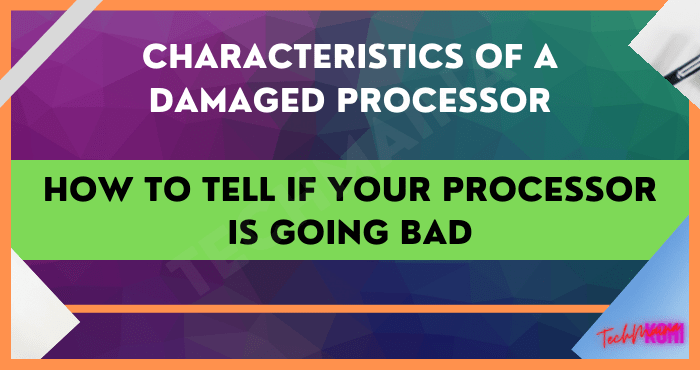In this article, we are going to share with you How to Tell If Your Processor Is Going Bad. So, let’s get started…
Know the characteristics of a damaged processor and how to fix it before replacing it with a new one.
As the main component of a computer, the processor must be kept in good condition.

The processor is indeed very important to maintain its condition because it is the center for managing computer work.
If the processor is damaged, the effects will spread to other computer components and even the work process can die completely.
There are several causes for the processor to fail, including:
- Overheating
- There is dust or dirt on the processor
- The specifications between RAM and Processor do not match
Therefore, you need to know the characteristics of a damaged processor to overcome unwanted things. Because the Processor component itself is quite expensive compared to other components.
You can find a more complete discussion of the characteristics of a damaged processor and how to fix it below.
Table of Contents
8 Characteristics of a Damaged Processor
Recognize the characteristics of a damaged processor before you replace it with a new one.
Of course, I will provide a way to overcome the damage to the processor if the damage is still in a mild stage.
1. Unnatural Beep Appears
Every time we turn on the computer, it will enter the process of checking hardware components by the BIOS.
Sometimes when checking hardware by BIOS, a ‘Beep’ sound is heard. The sound can indicate that your computer is normal or damaged.
If you hear an unusual beep sound, please check the BIOS Beep code installed on your computer and find out the cause.
Every computer has a different BIOS type, make sure you check the Beep code that matches the BIOS on your computer.
2. Blank Screen On Monitor
One of the characteristics of a damaged processor is the occurrence of a blank screen when turning on a computer or laptop.
This can happen because the BIOS does not respond to anything because the Processor as the main key is damaged.
If this happens, you inevitably have to replace the processor. But do not assume every blank screen occurs due to damage to the processor.
There are several other possibilities, it could be damage to the RAM, VGA, monitor cable, and other things.
Read Also:
3. The computer suddenly turns off when in use
One of the characteristics of a damaged processor is that the computer suddenly turns off when it is used.
This is because the processor is experiencing excessive heat (overheating). As a result, the physical processor suffered severe damage.
How to overcome more severe damage, you should turn off all electrically connected to the computer.
Please check the inside of the CPU, clean the inside of the dust, replace the fan if necessary, give thermal paste back to the processor and install a better heatsink.
It can also be caused by faulty RAM, faulty GPU, or unstable PSU voltage.
4. Failed When Opening Certain Programs
This problem will appear when we run certain programs. Usually, the program fails to open because the program being run is quite heavy.
There are several reasons why this can happen, it could be due to problematic RAM, corrupt files, and other things.
This can happen because you extract files that are quite large, install heavy programs, play games with high quality, and do other things.
The solution to overcome this, please check the physical state of your processor, is it fine or damaged.
5. Overheating the Heatsink
Excessive heat on the Heatsink can be a sign of damage to the processor. If the heatsink is already hot when the computer is just turned on, you should be aware of the damage to the processor.
6. System Only Temporarily Turns On or Repeated Restart
The computer always restarts when it is just turned on is also a characteristic feature of the processor being damaged.
When you turn on the computer and in a few moments it turns off again, it could be that your processor is damaged.
The solution to overcome this, please check the normal physical processor, clean it from dust and dirt on the processor cooler, use the thermal paste as an adhesive for the processor and cooler.
7. Check Physical Processor
The most effective way to find out the characteristics of a damaged processor is to look directly at the state of the processor.
Please check your processor, whether it has signs of damage as below:
- There are parts of the processor that are charred or burnt
- Loss of electricity to the processor
- Broken on the jumper pin
If you see the signs above, immediately repair or replace it with a new processor.
8. The Computer Can’t Turn on at All
For cases like this one of the causes is damage to the processor. But make sure other hardware components such as VGA, RAM, PSU, Motherboard, and other parts are not damaged.
If other components are not damaged, physically check the processor is damaged or not. If it is damaged, repair it immediately or replace it with a new one.
Closing
The following is a discussion of the characteristics of a damaged processor. What do you think about the article above?
Is it enough to help solve problems regarding a damaged processor? Please provide feedback in the comments column.
Thank you for visiting techmaina, look forward to other interesting articles about hardware only on techmaina.

![How To Fix: ALT GR Not Working On Windows 10 [2025] How To Fix ALT GR Not Working On Windows 10](https://techmaina.com/wp-content/uploads/2021/04/How-To-Fix-ALT-GR-Not-Working-On-Windows-10-218x150.png)
![Hard Drive Repair – How to Repair a Damaged Hard Drive [2025] Hard Drive Repair - How to Repair a Damaged Hard Drive](https://techmaina.com/wp-content/uploads/2020/12/Hard-Drive-Repair-How-to-Repair-a-Damaged-Hard-Drive.jpg)
![How to Check What Graphics Card You Have [2025] How to Check What Graphics Card You Have](https://techmaina.com/wp-content/uploads/2021/09/How-to-Check-What-Graphics-Card-You-Have-218x150.png)


![How To Fix: Avast VPN Not Working Error On Windows [2025] Best Methods To Fix Avast VPN Not Working On Windows](https://techmaina.com/wp-content/uploads/2021/04/Best-Methods-To-Fix-Avast-VPN-Not-Working-On-Windows-100x70.png)

![Latest Free IPVanish Premium Accounts List [2025] Latest Free IPVanish Premium Accounts List](https://techmaina.com/wp-content/uploads/2021/09/Latest-Free-IPVanish-Premium-Accounts-List-100x70.png)